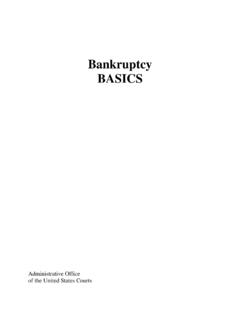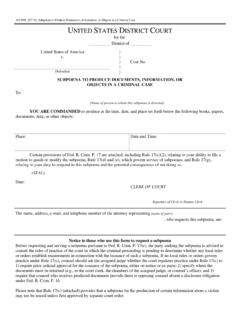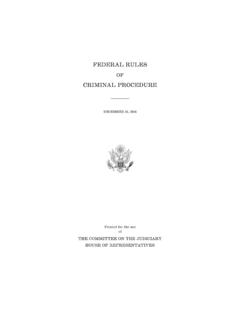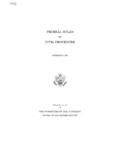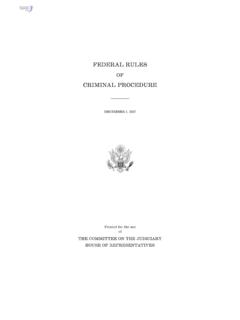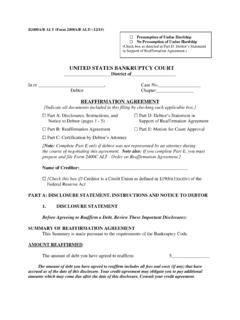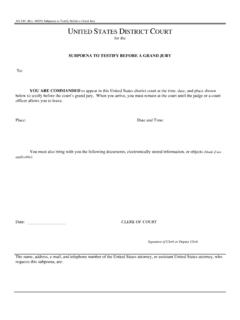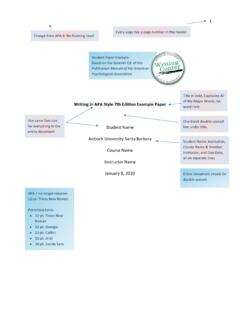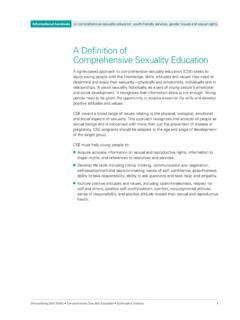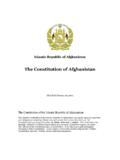Transcription of DISMISSING FEDERAL RULE OF CIVIL PROCEDURE 41 …
1 14-CV-D. DISMISSING FEDERAL RULE OF CIVIL PROCEDURE 41. Bradley Scott Shannon*. Despite its long pedigree, FEDERAL Rule of CIVIL PROCEDURE 41, the rule generally governing the dismissal of FEDERAL CIVIL actions, is ill-equipped to deal with the realities of modern FEDERAL CIVIL practice. But the many problems with Rule 41 need not be tolerated. As this Article demonstrates, Rule 41 can and should be amended in a manner that preserves much of its history, yet comports with these realities . An amended Rule 41 also would more clearly avoid running afoul of the substantive limitations imposed by the rules Enabling Act. I. INTRODUCTION. Dismissals play a prominent role in FEDERAL CIVIL It is no exaggeration to say that most actions are resolved by This fact alone would seem to make dismissals a subject worthy of study.
2 Though the FEDERAL rules of CIVIL PROCEDURE refer to dismissals in many places,3 dismissals are governed generally by FEDERAL Rule of CIVIL * Professor of Law, Florida Coastal School of Law. I thank Professors Stephen Burbank and Kevin Clermont, who, though not necessarily agreeing with the contents of this Article, were kind enough to provide helpful comments. 1. Dismissals also play a prominent role in state CIVIL practice and, to the extent that state practice parallels FEDERAL , much of what is said here applies there as well. Indeed, this might be particularly true in this area, for FEDERAL Rule of CIVIL PROCEDURE 41 the primary focus of this Article has served as a model for similar provisions in many states.
3 RESTATEMENT (SECOND) OF JUDGMENTS 19 cmt. b (1982). 2. Most actions are resolved by settlement. See Marc Galanter & Mia Cahill, Most Cases Settle : Judicial Promotion and Regulation of Settlements, 46 STAN. L. REV. 1339, 1339 (1994) (observing that settlement is the most frequent disposition of CIVIL cases in the United States ). Though surprisingly little systematic knowledge exists about settlement rates, one recent study of two large FEDERAL districts over a two-year period revealed an aggregate settlement rate of Theodore Eisenberg & Charlotte Lanvers, What is the Settlement Rate and Why Should We Care?, 6 J. EMPIRICAL LEGAL STUD. 111, 111 12, 115 (2009). Because a settlement typically results in a dismissal of the underlying action, see infra note 27 and accompanying text (discussing settlements in conjunction with dismissals), this study similarly suggests a dismissal rate of at least 67%.
4 See id. at 115. And, because this figure does not take into account the many other ways in which an action may be dismissed, some of which are quite common, see infra notes 19 20 and accompanying text (discussing the various types of dismissals), the total dismissal rate must be much higher. It might be observed, though, that there are other means of disposing of an action, and that not every disposition results in (or is caused by) a dismissal. See infra note 18 and accompanying text (distinguishing dismissals from other types of dispositions). 3. See Bradley Scott Shannon, Action Is an Action Is an Action Is an Action, 77 WASH. L. REV. 65, 117 18 (2002) (cataloging the various types of dismissals expressly provided for in the FEDERAL rules of 265.)
5 266 UNIVERSITY OF LOUISVILLE LAW REVIEW [Vol. 52:265. PROCEDURE Rule 41 was one of the original rules promulgated in 1938, and it has changed very little It is time for more substantial change. Regardless of whether Rule 41. ever served its purpose or even represented a correct statement of the relevant law it has become increasingly apparent that the rule is not adequately aligned with the realities of modern FEDERAL practice. This is perhaps most vividly demonstrated by the Supreme Court's decision in Semtek International Inc. v. Lockheed Martin Corp.,6 in which the Court relied upon an erroneous interpretation of Rule 41 holding that the phrase operates as an adjudication [on] the merits means only that such a dismissal precludes the relitigation of the same action in the same FEDERAL district court to avoid confronting the question whether the rule as applied in that case exceeded the Court's rulemaking But there are other problems so many, in fact, that the rule itself should be dismissed.]
6 That dismissal, though, should be without prejudice. Rule 41 can and should be saved, but only after these problems have been rectified. CIVIL PROCEDURE ). It might be observed, though, that many grounds for dismissal are not specifically mentioned in the FEDERAL rules of CIVIL PROCEDURE . One example is a dismissal pursuant to a contractual forum selection clause. See, , Lauro Lines v. Chasser, 490 495, 496 (1989) (holding that the denial of a motion to dismiss for enforcement of a forum-selection clause is not immediately appealable under the collateral order doctrine). Another is a dismissal for expiration of the applicable statute of limitation. See, , Semtek Int'l Inc. v. Lockheed Martin Corp.
7 , 531 497, 509 (2001). (holding that the claim-preclusive effect of the California FEDERAL court's dismissal .. of [an] action on statute-of-limitations grounds is governed by a FEDERAL rule that in turn incorporates California's law of claim preclusion ). Incidentally, as used in this Article, Rule (or rules ) refers to the FEDERAL rules of CIVIL PROCEDURE . 4. See FED. R. CIV. P. 41 ( Dismissal of Actions ). The full text of current Rule 41 is reproduced infra app. A. 5. See 9 CHARLES ALAN WRIGHT & ARTHUR R. MILLER, FEDERAL PRACTICE AND PROCEDURE : CIVIL 2361, at 406 07 (3d ed. 2008) ( FEDERAL Rule 41 has been amended seven times since it originally was promulgated in 1938. The amendments, however, have been substantively insignificant.)
8 It is doubtful if a single case would have been decided differently if the rule stood as it did in 1938 .. ). 6. Semtek, 531 497. 7. FED. R. CIV. P. 41(b); Semtek, 531 at 506. See also Stephen B. Burbank, Semtek, Forum Shopping, and FEDERAL Common Law, 77 NOTRE DAME L. REV. 1027, 1045 46 (2002) (footnotes omitted), stating: The drafting history [of Rule 41] makes it clear that the Court in Semtek was correct in positing that the rulemakers used the words operates as an adjudication [on] the merits in Rule 41(b) as the opposite of without prejudice, and thus as synonymous with the words with prejudice. It also reveals, however, that to the extent they thought about the question, the rulemakers believed that they had authority to define both when a dismissal would not be eligible to bar another action on the same claim and when it would be eligible for such effect, and that they sought to do the latter in Rule 41(b).
9 I have found no suggestion in this history that the rulemakers intended to cabin the effects to the rendering court. 2014] DISMISSING FEDERAL Rule of CIVIL PROCEDURE 41 267. The primary purposes of this Article, then, are to expose these many problems with Rule 41 and to propose some possible The Article will proceed as follows: In Part II, the Article will briefly describe the nature of dismissals in general and the various preclusive effects thereof. In Part III, the Article will compare this understanding of dismissals with the text of Rule 41. This comparison will reveal several problems with Rule 41 as currently written, many of which are quite serious. Then in Part IV, the Article will propose some amendments to Rule 41 that would solve the problems identified in Part III and more accurately reflect the way in which dismissals operate in Perhaps most significantly, the Article will conclude that although there are situations in which the relevant order or stipulation properly may prescribe the preclusive effect thereof, this should occur only in those situations in which that effect is not dictated by operation of law.
10 This change would not only be more consistent with the constraints imposed by the rules Enabling Act,10 it would prevent district courts as well as the rule itself from assigning a preclusive effect to a dismissal that it ought not bear. II. WHAT IS A DISMISSAL AND WHAT IS ITS EFFECT? Before engaging in a full-scale critique of Rule 41, it might be helpful to step back a bit and start with a review of the different types of dismissals and their various preclusive effects. Generally speaking, a dismissal is a means (though not the only means). of disposing of or otherwise resolving an More specifically, a dismissal is a disposition in favor of a defendant usually on grounds independent of the underlying merits of the action ( , the plaintiff's claims and the defendant's merits-based defenses).
